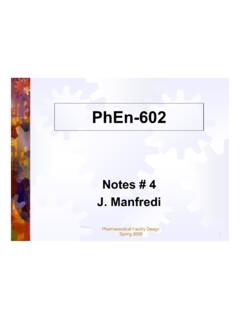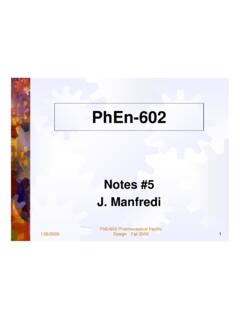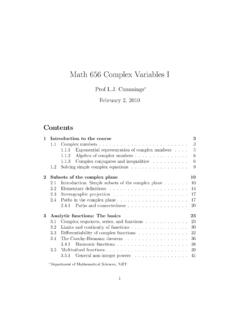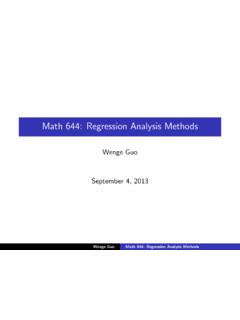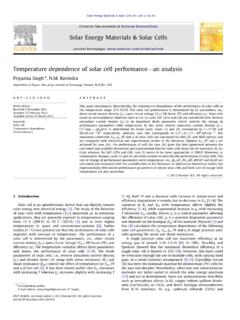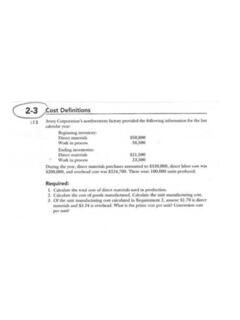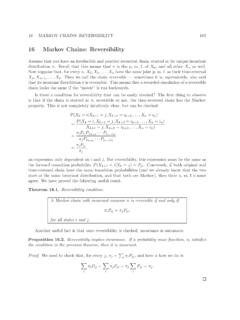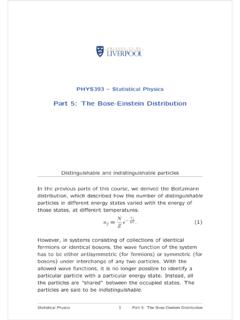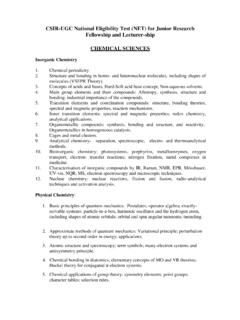Transcription of Phys 446 Solid State Physics Lecture 7 (Ch. 4.1 – 4.3, 4.6.)
1 Lecture 7 Phys 446 Solid State Physics Lecture 7 (Ch. , )Last time: Finished with phonons, optical and thermal properties. Today: Start with electronic properties of electron model. Fermi of states. Electronic heat capacityElectrons in metals: free electron model Simplest way to represent the electronic structure of metals Although great simplification, works pretty well in many cases, describes many important properties of metals In this model, the valence electrons of free atoms become conduction electrons in crystal and travel freely Neglect the interaction of conduction electrons with ions of the lattice and the interaction between the conduction electrons a free electron gas Fundamental difference between the free electron gas and ordinary gas of molecules: 1) electrons are charged particles to maintain the charge neutrality of the whole crystal, we need to include positive ions.
2 This is done within the jelly model : the positive charge of ions is smeared out uniformly throughout the crystal - charge neutrality is maintained, no field on the electrons exerted2) Free electron gas must satisfy the Pauli exclusion principle, which leads to important electron gas in one dimensionAssume an electron of mass m is confined to a length L by infinite barriersSchr dinger equation for electron wave function n(x): En-the energy of electron orbitalassume the potential lies at zero H includes only the kinetic energy Note:this is a one-electron equation neglected electron-electron interactionsGeneral solution: Asinqnx+ Bcosqnxboundary conditions for the wave function: B= 0; qn= n/L; n-integerSubstitute, obtain the eigenvalues: What is Hamiltonian?
3 First three energy levels and wave-functions of a free electron of mass m confined to a line of length L: picture from KittelWe need to accommodate N valence electrons in these quantum principle: no two electrons can have identical quantum numbers. Electronic State in a 1D Solid is characterized by quantum numbers n and ms, where n describes the orbital n(x), and ms- the projection of the spin: ms= . each orbital labeled by the quantum number n can accommodate two electrons, one with spin up and one with spin down nF- the highest filled energy level. Start filling the levels from the bottom (n = 1) and continue until all N electrons are accommodated. Condition 2nF= N determines nFFermi energyThe energy of the highest occupied level is called the Fermi energy EF For the one-dimensional system of N electronsFinite temperature: the Fermi - Dirac distributionThe ground State of the N electron system at zero temperature: all the electronic levels are filled up to the Fermi energy.
4 All the levels above are happens if the temperature is increased? The kinetic energy of the electron gas increases with temperature some energy levels become occupied which were vacant at 0 K; some levels become vacant which were occupied at 0 K. The distribution of electrons among the levels is described by the distribution function, f(E) - the probability that the level E is occupied11)()(+= TkEBeEf Fermi - Dirac distribution : the chemical potential. It can be determined in a way that the total number of electrons in the system is equal to N. At T= 0 K = EF11)()(+= TkEBeEf f(E) at T = 0 K and T> 0 KAt any Tif f(E) = 1/2 when E = High energy tail of f(E), when E - >> kBT:called maxwell boltzmann distributionTkEBeEf)()( = Effect of temperature on Fermi-Dirac distributionFree electron gas in three dimensionsThe Schr dinger equation in the three dimensions:If the electrons are confined to a cube of edge L, the solution isintroduce periodic boundary conditions, as we did for lattice vibrations assume that our crystal is infinite and disregard the influence of the outer boundaries of the crystal on the solution require that our wave function is periodic in x, y, and z directions with period L, so that and similarly for the y and z coordinates.
5 The solution of the Schr dinger equation satisfying these boundary conditions has the form of the traveling plane wave:rkkr =iAe)( provided that the component of the wave vector k satisfywhere nx, ny, and nz- integerssubstitute this to the Schr dinger equation, obtain the energy of the orbital with the wavevectork:Wave functions k the eigenfunctions of the momentum operator The eigenvalue of the momentum is k. ==ipThe velocity of the electron is defined by v= p/m= k/m/FBEkFermi energy and Fermi momentumIn the ground State a system of N electrons occupies states with lowest possible energies all the occupied states lie inside the sphere of radius kF. The energy at the surface of this sphere is the Fermi energy magnitude of the Fermi wave vector kFand the Fermi energy are related by the equation:The Fermi energy and the Fermi momentum are determined by the number of valence electrons in the system need to count the total number of energy orbitals in a sphere of radius kFwhich should be equal to volume element in the k space (volume per single set of kx, ky, and kz) is equal to 32 L Thus in the sphere of the total number of states is343 FFkV =where does the factor 2 come from ?
6 3123 =VNkF - depends only of the electron concentrationObtain then for the Fermi energy:and the Fermi velocity: 322232 =VNmEF =3123 =VNmvF =density of statesEFkBTDensity of statesDefined as the number of electronic states per unit energy range an important characteristic of electronic properties of a Solid To find it, write the total number of orbitals of energy < E. We had 3222)(32 =VENmE = 232223)( ==mEVEN So, the density of states D(E)is32122223()()22dNVmN EDEEdEE === =the integral- total number of electrons in system (at 0K)At T 0 should take into account the Fermi distribution :Heat capacity of the electron gas Classical statistical mechanics - a free particle should have 3kB/2 ;N atoms each give one valence electron and the electrons are freely mobile the heat capacity of the electron gas should be 3 NkB/2 Observed electronic contribution at room T is usually < of this value The discrepancy is resolved by taking into account the Pauli principle and the Fermi distribution function.
7 When we heat the crystal from 0 K, not every electron gains an energy ~ kBTas expected classically, but only the electrons within an energy range kBTof the Fermi level can be excited thermally. These electrons gain an energy, which is itself of the order of kBTQualitative solution to the problem of the heat capacity of free electron gasIf N is the total number of electrons, only a fraction of the order of kBT/EFcan be excited thermally at temperature T -only these lie within an energy range of the order of kBTof the top of the energy distributionEach of these NkBT/EFelectrons has a thermal energy of the order of kBT The total electronic thermal kinetic energy U is of the order of U (NkBT/EF)kBT. The electronic heat capacity is then Cel= dU/dT NkB(kBT/EF) - directly proportional to T, in agreement with the experimentAt room T Celis smaller than the classical value NkBby a factor kBT/EF, which is or expression for the electronic heat capacity at low temperatureskBT<< EF.
8 For room T kBT 26 meV ; EF~ few total energy of a system of N electrons at temperature T iswhere f(E,T) is the Fermi distribution function and D(E) is the density of statesheat capacity is- only f(E,T) depends on Tlittle trick: rewriteusing the fact that We are interested only in temperatures for which kBT<< EF df/dTis large only at the energies very close to the Fermi energy can ignore the variation of D(E) under the integral soAlso ignore the variation of the chemical potential with temperature and assume that = EF(good approximation at room Tand below).ThenandTaking into account that EF >> kBT, we can put the low integration limit to - and obtainFor a free electron gas use for the density of statesENED23)(=Obtainwhere the Fermi temperature is defined as TF= EF/kBResult is similar to what we obtained from qualitative argumentsThe heat capacity at temperatures much below both the Debye temperature and the Fermi temperature can be represented as:Electronic term dominates at sufficiently low T and can be by fitting the experimental CT T =+ =+Electrical conductivityDrude model: the simplest treatment of the electrical conductivity.
9 Four major assumptions:1. Electrons are treated as classical particles within a free-electron approximation: neglect the interactions with other electrons and ions; no external electromagnetic fields - move uniformly in a straight line. In the presence of fields - move according to Newton's laws2. Electrons move free only between collisions with scattering centers. Collisions, are instantaneous - abruptly alter the electron velocity. A particular type of scattering centers does not matter in the Drude model. Simply assume that there is some scattering Electron experiences a collision with a probability per unit time 1/ . The time an average time between the two consecutive scattering events - known as, the collision time(relaxation time).
10 The relaxation time is taken to be independent of electron's position and Electrons achieve thermal equilibrium with their surroundings only through collisions. These collisions are assumed to occur in a simple way: immediately after each collision an electron emerges with a velocity that is not related to its velocity before the collision, but randomly directed and with a speed corresponding to the temperature at the place where the collision occurred. Application of the Drude model for electrical conductivity in a metalOhm's law: j= conductivity; =1/ - resistivityj = I/A; V2-V1= EL, R = L/ A= L/A I= (V2-V1)/Rn electrons per unit volume all move with velocity v j|| vin a time dt n(vdt)Aelectrons will cross an area A perpendicular to the direction of flow charge crossing A in dtwill be nevAdt j = nevv is the average electronic velocity or drift velocityLet t - time elapsed since electron's last collision.
